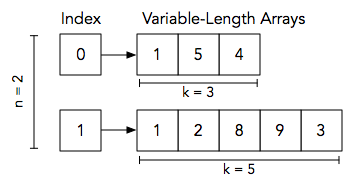#include <cmath>
#include <cstdio>
#include <vector>
#include <iostream>
#include <algorithm>
using namespace std;
int main() {
/* Enter your code here. Read input from STDIN. Print output to STDOUT */
int vecrow , querys ;
cin >> vecrow >> querys;
vector<vector<int>> vec ;
vec.resize(vecrow);
for(int i = 0 ; i < vecrow ; i++)
{
int veccolumn, memnum;
cin >> veccolumn ;
vec[i].resize(veccolumn);
for(int j = 0; j < veccolumn ; j++)
{
cin >> memnum ;
vec[i][j] = memnum ;
}
}
int row, colum ;
for(int i = 0 ; i < querys ; i++)
{
cin >> row >> colum ;
cout << vec[row][colum] << endl ;
}
return 0;
}
Consider an n-element array, a, where each index i in the array contains a reference to an array of Kᵢ integers (where the value of Kᵢ varies from array to array). See the Explanation section below for a diagram.
Given a, you must answer q queries. Each query is in the format i j, where i denotes an index in array a and j denotes an index in the array located at a[i]. For each query, find and print the value of element j in the array at location a[i] on a new line.
Click here to know more about how to create variable sized arrays in C++.
Input Format
The first line contains two space-separated integers denoting the respective values of n (the number of variable-length arrays) and q (the number of queries).
Each line i of the n subsequent lines contains a space-separated sequence in the formatk a[i]₀ a[i]₁ … a[i]k₋₁
describing the k-element array located at a[i].
Each of the q subsequent lines contains two space-separated integers describing the respective values of i (an index in array a) and j (an index in the array referenced by a[i]) for a query.
Constraints
.1 <= n <= 10^5
.1 <= q <= 10^5
.1 <= k <= 3 * 10^5
.n <= Σk <= 3 * 10^5
.0 <= i < n
.0 <= j < k
.All indices in this challenge are zero-based.
.All the given numbers are non negative and are not greater than 10^6
Output Format
For each pair of i and j values (i.e., for each query), print a single integer that denotes the element located at index j of the array referenced by a[i]. There should be a total of q lines of output.
Sample Input2 23 1 5 45 1 2 8 9 30 11 3
Sample Output59
Explanation
The diagram below depicts our assembled Sample Input:
We perform the following q = 2 queries:
